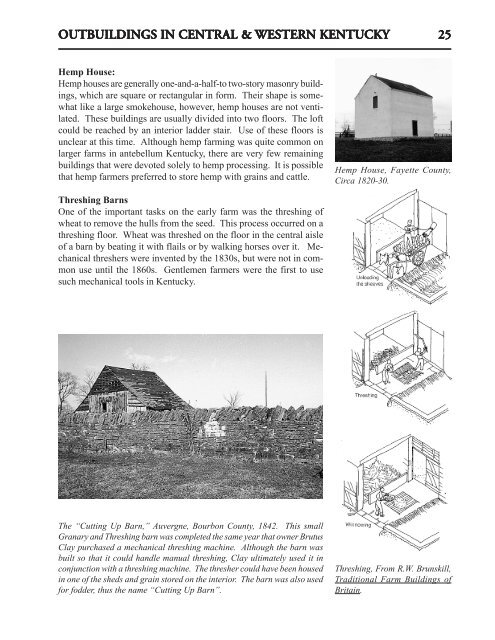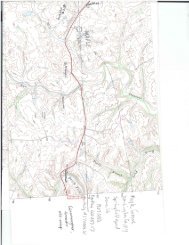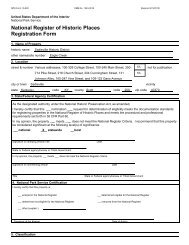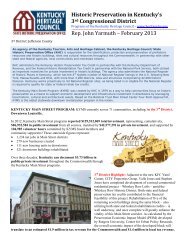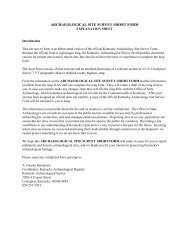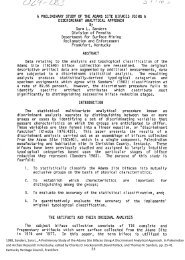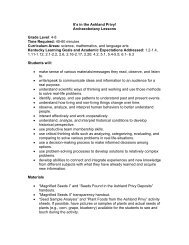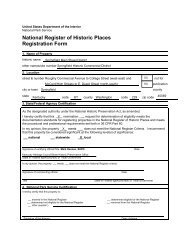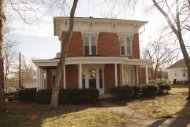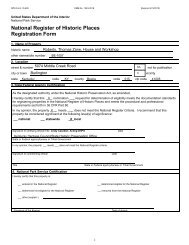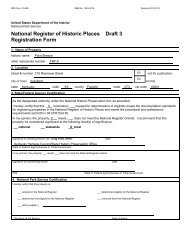Agricultural and Domestic Outbuildings in Central and Western
Agricultural and Domestic Outbuildings in Central and Western
Agricultural and Domestic Outbuildings in Central and Western
You also want an ePaper? Increase the reach of your titles
YUMPU automatically turns print PDFs into web optimized ePapers that Google loves.
OUTB OUTB OUTBUILDINGS OUTB OUTB UILDINGS IN IN CENTRAL CENTRAL & & WESTERN WESTERN KENTUCKY KENTUCKY 25<br />
25<br />
Hemp House:<br />
Hemp houses are generally one-<strong>and</strong>-a-half-to two-story masonry build<strong>in</strong>gs,<br />
which are square or rectangular <strong>in</strong> form. Their shape is somewhat<br />
like a large smokehouse, however, hemp houses are not ventilated.<br />
These build<strong>in</strong>gs are usually divided <strong>in</strong>to two floors. The loft<br />
could be reached by an <strong>in</strong>terior ladder stair. Use of these floors is<br />
unclear at this time. Although hemp farm<strong>in</strong>g was quite common on<br />
larger farms <strong>in</strong> antebellum Kentucky, there are very few rema<strong>in</strong><strong>in</strong>g<br />
build<strong>in</strong>gs that were devoted solely to hemp process<strong>in</strong>g. It is possible<br />
that hemp farmers preferred to store hemp with gra<strong>in</strong>s <strong>and</strong> cattle.<br />
Thresh<strong>in</strong>g Barns<br />
One of the important tasks on the early farm was the thresh<strong>in</strong>g of<br />
wheat to remove the hulls from the seed. This process occurred on a<br />
thresh<strong>in</strong>g floor. Wheat was threshed on the floor <strong>in</strong> the central aisle<br />
of a barn by beat<strong>in</strong>g it with flails or by walk<strong>in</strong>g horses over it. Mechanical<br />
threshers were <strong>in</strong>vented by the 1830s, but were not <strong>in</strong> common<br />
use until the 1860s. Gentlemen farmers were the first to use<br />
such mechanical tools <strong>in</strong> Kentucky.<br />
The “Cutt<strong>in</strong>g Up Barn,” Auvergne, Bourbon County, 1842. This small<br />
Granary <strong>and</strong> Thresh<strong>in</strong>g barn was completed the same year that owner Brutus<br />
Clay purchased a mechanical thresh<strong>in</strong>g mach<strong>in</strong>e. Although the barn was<br />
built so that it could h<strong>and</strong>le manual thresh<strong>in</strong>g, Clay ultimately used it <strong>in</strong><br />
conjunction with a thresh<strong>in</strong>g mach<strong>in</strong>e. The thresher could have been housed<br />
<strong>in</strong> one of the sheds <strong>and</strong> gra<strong>in</strong> stored on the <strong>in</strong>terior. The barn was also used<br />
for fodder, thus the name “Cutt<strong>in</strong>g Up Barn”.<br />
Hemp House, Fayette County,<br />
Circa 1820-30.<br />
Thresh<strong>in</strong>g, From R.W. Brunskill,<br />
Traditional Farm Build<strong>in</strong>gs of<br />
Brita<strong>in</strong>.


